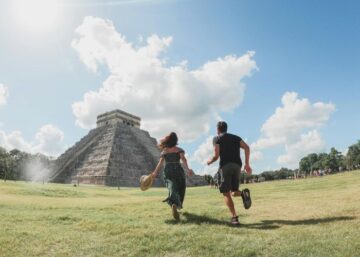A Team-Building Retreat in Mexico: Cultivating Collaboration and Camaraderie Offsite
A Team-Building Retreat in Mexico: Cultivating Collaboration and Camaraderie Offsite! Imagine an engaging getaway focused on strengthening ties, fostering innovation, and enhancing communication within your team. Welcome to the concept of a team-building retreat. Picture a captivating escape, meticulously designed to weave stronger bonds, ignite innovation, and refine communication among your team. In the vibrant tapestry of Mexico’s destinations, from the bustling streets of Mexico City to the tranquil shores of Tulum. There lies the perfect canvas for nurturing team dynamics.
What is a Team-Building Retreat?
A team-building retreat takes employees from their usual work environment to participate in activities to boost teamwork, communication, and morale. It’s an intentional pause from daily tasks, offering a unique mix of professional development and relaxation. Aimed at improving overall team performance.
During these types of retreats, participants engage in various exercises and challenges designed to foster trust, collaboration, and problem-solving skills. From ropes courses to group problem-solving activities, each activity is carefully chosen to address specific aspects of team dynamics. Additionally, the retreat provides an opportunity for team members to bond on a personal level, fostering stronger relationships and a deeper understanding of each other’s strengths and weaknesses. Ultimately, the experiences gained during these retreats can have a lasting impact on the team’s cohesion and effectiveness back in the workplace.
Why Organize One?
The rationale behind organizing a team-building retreat is multifaceted:
- Improved Communication: Activities designed to enhance communication skills can break down barriers and encourage open dialogue among team members.
- Increased Cohesion and Morale: Employees can form stronger bonds by participating in shared experiences, leading to a more cohesive and motivated team.
- Stress Reduction: A change of scenery and pace can significantly reduce work-related stress, refreshing the team.
- Enhanced Problem-solving Skills: Challenges that require collective brainstorming and strategic thinking can sharpen the team’s problem-solving abilities.
- Recognition and Reward: Treating the team to a retreat acknowledges their hard work and contributions, boosting loyalty and job satisfaction.
What to Include in the Agenda
Creating a balanced retreat agenda is key to maximizing its benefits. Consider including:
- Team-Building Exercises: Opt for a mix of fun and challenging activities that require teamwork and strategic thinking.
- Workshops and Training Sessions: Incorporate sessions focused on developing skills relevant to your team’s needs, such as leadership or communication.
- Feedback and Reflection Time: Schedule sessions for team members to share insights and feedback about the retreat and their usual work environment.
- Leisure Activities: Allow time for relaxation and informal bonding, which can be as valuable for team cohesion as structured activities.
- Action Plan Development: Dedicate time towards the end of the retreat to discuss how to apply insights gained to everyday work scenarios.
Tips for a Great Team-Building Retreat
- Set Clear Objectives: Identify what you hope to achieve before planning the retreat. Clear goals help shape a more effective agenda.
- Involve the Team in Planning: Solicit input on activities and topics to ensure the retreat meets everyone’s expectations and addresses their needs.
- Choose an Inspiring Location: Select a venue that will excite and motivate the team, whether a tranquil countryside retreat or an adventurous outdoor locale.
- Hire Professional Facilitators: Consider bringing in experts to lead team-building exercises or workshops, ensuring enjoyable and beneficial activities.
- Follow Up Post-Retreat: To maintain momentum, implement a plan to integrate the retreat’s positive outcomes into daily work life.
Conclusion
Investing in a team-building retreat is more than just a company expense; it’s a strategic investment in your team’s well-being and productivity. By stepping away from the office and engaging in targeted, enjoyable activities, your team can return to work reenergized, more cohesive, and with improved skills to tackle future challenges together. Remember, the strongest teams grow up on a foundation of mutual respect, understanding, and shared experiences—goals that a well-planned team-building retreat can help you achieve.



